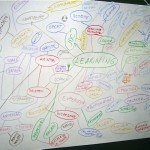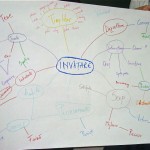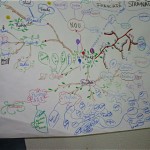This week sees another of our mini series of blog posts featuring particular projects or areas of research and development in Technology Enhanced Learning. This series will focus on careers and career transitions, based on a number of different projects in which Pontydysgu is involved.
The EU funded G8WAY project is looking at transitions between school and work, school and university and university and work. It aims to use Web 2.0 and social software to support learners in making those transitions. And of course that raises a series of methodological questions. What issues are effecting young people in transitions? What kind of support do they presently receive? What works and what doesn’t? How do they use information and communication technologies? How do they think such technology could help them? And, in the context of a project involving partners from six different European projects, are the issues raised specific to particular countries or educations systems or are they common to learners in the different countries? Most critically, how do we find out? We need this information in order to start designing software applications which can support young people. Of course we could undertake a large scale survey. But G8WAY has limited resources and is under some time pressure.
After some discussion we decided to undertake a methods based on identifying personas. The initial results are very promising, proving not only a basis for use cases for designing software applications, but also proving a rich picture of the issues facing young people in managing transitions. In today’s post I will outline the methodology we have used. Tomorrow I will publish some of the initial case studies undertaken as part of developing the personas.
Using story telling and perosnas to research transitions: A short guide
1. Introduction – Storytelling and personas as a way of understanding transitions
Scientific. research seeks to draw out key concepts and ideas by abstraction and the application of logic (Bruner, 1996). In a holistic approach to understanding and meaning making story telling and narrative can enhance such scientific enquiry in order to examine actions, intentions, consequences and context. (See: http://www2.parc.com/ops/members/brown/storytelling/JSB.html John Seely Brown: ‘Story telling’ for more on this approach).
A good story should be emotionally engaging, capable of application in different contexts and provide a broader framework for understanding generalities, partly because there is a certain looseness of ideas. Generalities in this sense are different from knowledge derived from abstraction: in this case learning and knowledge are the result of multiple intertwining forces: content, context, and community.
Following Brown (op cit), in purposeful storytelling people should get the central ideas quickly and stories should communicate ideas holistically, naturally, clearly and facilitate intuitive and interactive communication. Our intention therefore is use story telling to enable us to imagine perspectives and share meanings about different educational transitions by conjuring up pictures more conducive to a culture of learning and development than a formal analytical presentation which is more in the form of knowledge transmission.
The G8WAY project itself is focused upon an abstraction: processes of transition. Further it fits within the enlightenment tradition of knowledge and learning being forces for good and the path to an improved future, both individually and at a societal level.
Obviously the main focus for the G8WAY project is an analysis of real-world transition practices, resulting in the development of sound general conceptual and pedagogical models for supporting learners in the transition process and ways to overcome barriers. This approach has considerable value but in order to understand the variety of transition processes and experiences of young Europeans a story telling approach could provide us with a richer background enabling us to develop scenarios and provide social software to support the transition process.
We propose to tell our stories in the form of personas.
2. About Personas
Personas are fictional characters created to represent the different user types within a targeted demographic, attitude and/or behaviour set that might use a site, brand or product in a similar way (Wikipedia). Personas can be seen as tool or method for design. Personas are useful in considering the goals, desires, and limitations of users in order to help to guide decisions about a service, product or interaction space for a website.
A user persona is a representation of the goals and behaviour of a real group of users. In most cases, personas are synthesised from data collected from interviews with users. They are captured in one to two page descriptions that include behaviour patterns, goals, skills, attitudes, and environment, with a few fictional personal details to make the persona a realistic character. Personas identify the user motivations, expectations and goals responsible for driving online behaviour, and bring users to life by giving them names, personalities and often a photo. (Calabria, 2004)
Personas can be based on research into users and should not be based purely on the creator’s imagination. By feeding in real data, research allows design teams to avoid generating stereotypical users that may bear no relation to the actual user’s reality.
Tina Calabria (2004) says personas are relatively quick to develop and replace the need to canvass the whole user community and spend months gathering user requirements and help avoid the trap of building what users ask for rather than what they will actually use.
Here is a sample persona created by the Seventh Framework MATURE project looking at strategies for knowledge development and learning by careers advisors. This may be helpful to you in creating Personas or you can just skip to the next section.
Name
Andrew
Motto
No idea how I learned that – it just happened!
Education and professional background
Andrew has gained an off-the-job postgraduate qualification in career guidance, together with an employment based National Vocational Qualification Level 4 in information, advice and guidance (IAG). Additionally, organisational training also formed part of his induction. As part of his on-the-job training, there were opportunities to visit employers and research different sectors of the labour market.
Role / degree of standardization
Andrew has been working as a careers adviser for the last 3 years. There is little standardisation to his work as has to react to the needs of the clients.
Workplace / colleagues
He works in one secondary school helping young people with career decisions ensuring that they have the skills to make informed decisions. When not in school, he works in an open administrative central office with his laptop – hot-desking.
Learning
Andrew likes to learn and is keen to find out more about different websites which can help him further his knowledge of the local labour market.
Knowledge
Andrew has to continuously acquire knowledge in the form of national, regional and local labour market information. This includes: education, training and employment opportunities; occupational trends and forecasts; information on local employers etc. Over the last 3 years, Andrew has gained a significant amount of local knowledge about the labour market and the education, training and employment opportunities available. This knowledge has not be gained through any conscious process or training. It was considered as ‘something you get to know’. As a new employee, Andrew asked questions of his colleagues to gain this information and knowledge. By reading internal communications sent by email and local newspapers he has been able to gain knowledge about the local labour market, which is central to his role, exemplifying his title as a knowledge worker.
Content types
He primary uses office software, email, the internet, organisation management information systems. Information can be received in both electronic and hard copy.
Structures
Information on clients is stored on a national MIS maintained by the organisation. Local intranets are available for storing and retrieving information.
Problem solving and other knowledge routines
The internet has become a valuable resource for researching and developing knowledge of the local labour market and the available opportunities. A favourite website, Planit Plus, has information on local opportunities and labour market information (LMI) and is often utilised. Email communication for colleagues also ensures that he is aware of current opportunities for training and employment in the local area. This soft data is vital to his work and needs to be continuously updated. Due to work pressures, he believes that in the current work climate there is little time to undertake employer visits to gain (and develop) knowledge about local employers. Time to research different sectors and gather LMI for analysis and synthesis is restricted and considered a luxury. Advantage is taken any opportunity presenting itself. Andrew recognises that he would value more time to develop his local knowledge by not only supplementing it with hard data, but also by returning to knowledge development methods used during his training and induction within the organisation.
Reaction to requests from colleagues
Requests for colleagues are normal by email and are usual a general query to see if he knows a particular piece of information. As a new employee, Andrew asked questions of his colleagues to gain this information and knowledge. By reading internal communications sent by email and local newspapers he has been able to gain knowledge about the local labour market, which is central to his role, exemplifying his title as a knowledge worker.
Communication strategy / approach to knowledge sharing
Serendipitous knowledge maturation – Knowledge sharing and maturing is ad hoc and haphazard. Knowledge typically developed and shared as part of a development process for a product or service within the organisation or as part of training. Over the last 3 years, Andrew has gained a significant amount of local knowledge about the labour market and the education, training and employment opportunities available. This knowledge has not be gained through any conscious process or training. It was considered as ‘something you get to know’.
Formal training
He regularly has the opportunity to attend training courses run by the organisation and has regular review sessions with a line manager.
Important tools
Office tools, internet (including Planit Plus, organisational website), email, MIS
Motivation / drives / interests
Andrew is sceptical about some applications of IT and does not like to rely on them for information. He says it is unprofessional to go to the organisational website with a client to show them some information and then it freezes or is unavailable.
Task management
Andrew has no daily or weekly routine as he is reactive to client needs and requests. Task are managed by an electronic diary.
Attitude towards technology
He is keen to use technology and sees it as a way forward for many of clients in developing their research skills in locating local education, training and employment opportunities. Email communication is central to networking and finding out what is happening in the local labour market.
3. Creating personas for G8WAY
3.1 Decide on a research approach
The purpose of the research is to identify trends or patterns in user behaviours, expectations and motivations in transitions to form the basis of the personas. The best ways to gather this data is to talk to people having completed, or are currently undergoing, educational transitions. This might be through individual interviews or through a focus group or group discussion. You should explain to them first the basic aims of the project and that all information gathered will only be used for research purposes and will be anonymised (note in some countries / institutions you may have to get them to sign formal papers agreeing to this). The information we wish to know might include the following. However, this should not be used as a questionnaire. We want to encourage participants to explore around the topic and reveal their motivations, frustrations etc. Therefore it is only a starting basis for the research. Questions should follow the natural course of conversation which is dominated to a great extend by the topics chosen by the participant.
Background
- Age
- Gender
- Educational / work background
- Social background e.g. have they moved away from home, do they work in a group, on their own, if they at school what is their planned future careers, if at university how long have they been there?
Transitions
- What transition are they currently undergoing (or have undergone), including specific details?
- What did they experience during this transition period?
- How did and do they perceive this transition, before and after it happened?
- What went well?
- What were the problems / issues?
- Did they get support – did they ask for support or was it a service available to them?
- Who provided support? (examples: employment agencies, teachers, friends…)
- What sort of support – was it providing them with information, with guidance, help with problem solving, mentoring or access to learning? (here, it might be useful to give some ideas e.g. employment agency,
- how and where did they get that support – in school, in social settings, in work?
- How did it help – or did it not?
- What motivated them to get support?
- What kind of support would they have liked to have/ did they miss?
Information and Communication Technologies
- Did they use the internet for support in transitions?
- If so what did they use it for?
- What software did they use e.g. Google for searches, forums, web sites, social networks?
- What support did they find best for them?
- Which other internet tools can they think of/ do they know that can be supportive
- How proficient would they say they are in using the internet?
- What advice would they give us in developing the project?
3.2 Analyse research data and identify persona set
Review all the research data and look for patterns in attitudes and behaviours. For example, if you interviewed people about travel, you might find patterns like users who are price driven as opposed to quality driven, users who travel frequently as opposed to infrequently, and users who prefer to research their holiday rather than asking others for suggestions.
Whilst listing these patterns, you will begin to see clusters of attitudes and behaviours that make up different personas, such as the frequent traveller that is skilled in researching holidays and finding the best prices. This persona is motivated by keeping the cost of each holiday down so they can travel more in the future. The persona’s goal is to go on as many holidays as possible.
Once you have defined these clusters of attitudes and behaviours, give each persona a brief description, such as ‘independent traveller’ or ‘bargain hunter’. There is no ideal number of personas, however try to keep the set small. Three or four personas work as effective design tools, whilst over ten personas may introduce the same confusion as a large user requirements document.
This means ideally you should try to talk to ten or so people in order to gain enough evidence for your persona. This could be through a focus group, through formal interviews or though informal chats.
3.3 Writing personas
Start writing the personas by adding details around the behavioural traits. Select details from your research, such as working environment, frustrations, relationships with others, skill level, and some demographics. Give each persona a name.
Here are some more tips to follow:
- Keep your personas to one page, so they remain effective communication tools and can be referred to quickly during design discussions.
- Add personal details but don’t go overboard.
- Include goals for each persona. This can include experience goals as well as end goals. An experience goal could be as simple as ‘not to look stupid’, whilst an end goal would be ‘remain informed about the company’.
Once your personas are written, review them to ensure they have remained realistic and based on your research data. Check that you have a manageable number of personas, and if two personas seem close in behaviours and goals, see if you can merge them into one persona.
References
Bruner, Jerome S (1996) The Culture of Education. Cambridge, Mass.: Harvard University Press,
Calabria T, (2004) An introduction to personas and how to create them, http://www.steptwo.com.au/papers/kmc_personas/index.html
Seely Brown J, Story Telling, http://www2.parc.com/ops/members/brown/storytelling/JSB.html






